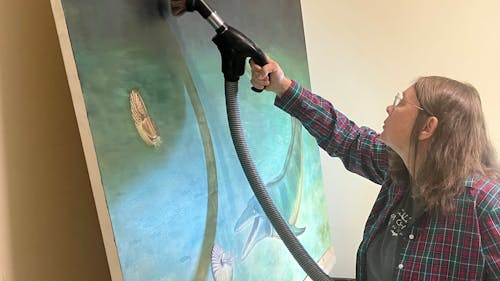Rutgers Geology Museum celebrates 150 years with painting unveiling ceremony

The Rutgers Geology Museum will unveil a newly-restored painting of a Mosasaur to celebrate the institution’s 150th anniversary on Thursday, according to a press release.
Lauren Neitzke-Adamo, director of the Rutgers Geology Museum, said the idea for an unveiling of the Mosasaur painting emerged when the artist, Jeanne Filler Scott, contacted the museum to inquire about the painting's whereabouts.
Scott created the painting in 1977, according to the press release. Since then, the painting has been displayed in the Rutgers Geology Museum.
Neitzke-Adamo said that during the conversation with Scott, the museum explained that they still maintained possession of the painting but it had degraded from its original state. Upon hearing that, Scott put forward an initiative to restore the painting.
"We kind of had the idea (that) if we can bring (the painting) back by the end of this year, we should celebrate it coming back to the museum and then tie it into the history of the museum," Neitzke-Adamo said. "And then, because we were doing a Mosasaur-themed painting, we decided to do the whole (anniversary) event around Mosasaurs."
Along with Scott’s painting, she said the event would feature artworks from the Zimmerli Art Museum, fossils from the New Jersey State Museum and a guest lecture on the Mosasaur presented by an expert from the American Museum of Natural History.
"Our plan prior to (the pandemic) for this year was to have a year-long celebration of events in-person celebrating the (museum’s) history, (having) guest speakers and things like that," she said. "That didn’t happen … (This event) all came together from this idea like 'OK, we're back in person, let's do something to celebrate and wrap this up.'"
In 1872, the museum became the first in the country to be centered around geology, said Carol McCarty, an independent researcher in the Department of History. Since then, the museum has contributed to developing geological sciences relevant to Rutgers and the nation.
"The Rutgers Geology Museum was one of the first concrete materializations that resulted from (New Jersey’s acceptance of the Morrill Land-Grant Act)," she said. "It represents a long geologic, mineralogical and educational history specific to Rutgers but is also representative of the progression of these fields and history within the U.S."
Over time, Nietzke-Adamo said the museum had supported students in both the sciences and arts. For example, students in the Mason Gross School of the Arts use the space for creative thinking, while students studying history can obtain professional development opportunities there.
Nietzke-Adamo said that as the museum continues its operations, it hopes to return to its pre-pandemic activities and prior level of community involvement. She said that in January, the museum will hold its Annual Open House and continue to coordinate programs such as nighttime events and group tours.
In the long run, she said the museum seeks to maintain its historical appearance and atmosphere while also integrating everyday activities and accessibility services, such as elevators. The absence of such services is a consistent issue within historic buildings.
Nietzke-Adamo said she hopes that both this celebration and future museum events help Rutgers students, regardless of if they are in the sciences, to recognize the deep ancestry that the museum, the University and New Jersey have.
"It’s a natural science, but it's so much more," Nietzke-Adamo said. "It’s learning about your past and its intersection with the present and the future … What we see today is not how it always will be and how it always has been."



